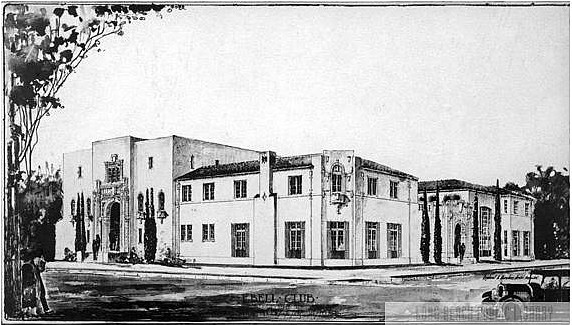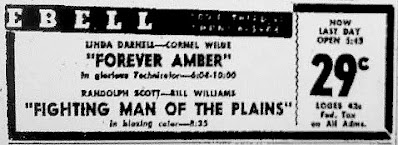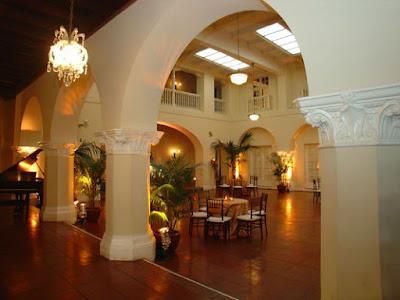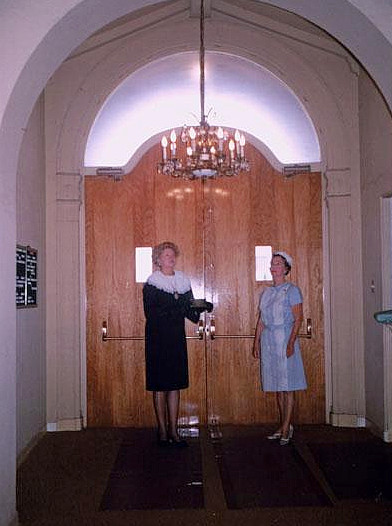1100 E. 3rd St. Long Beach, CA 90802 | map |
Opened: March 9, 1925 in a building that was a replacement for an earlier Ebell clubhouse.
The
building is on the southeast corner of 3rd and Cerritos Ave., eight
blocks east of Long Beach Blvd. In addition to a theatre designed for
both films and stage presentations, the building included meeting rooms,
a kitchen and a library. It's a 50,000 s.f. building. The theatre was leased out as a commercial film house. It's
called Hoyt's Ebell Theatre in this c.1925 photo from the Los Angeles Public Library collection.
The Long Beach Ebell Club, an all-women's
social and charitable organization, was established in 1896 with the goal of furthering
cultural activities in Long Beach. Within a few years of the
founding, most of the women of education and affluence in the area belonged to
the club. This Long Beach organization was a local chapter of a broad national movement.
Architect: Raphael A. Nicholais was the architect according to the data on a rendering, with C.T. McGrew and Sons credited as "designers" of the building, whatever that may mean. The building is credited to Clark Philip on page 195 of "
An Architectural Guidebook To Los Angeles." It's on Google Books.
A Long Beach real estate website noted:
"The
Ebell Club and Theatre was built in 1924 by Clark Philip / C.T. McGrew.
No expense was spared during its construction. It is an example of
Churrigueresque architecture. Its lavish, sculpted facade style date
back to Spanish architect Jose Churriguera (1650-1723) who developed the
style that is characterized by play of light and shade through lush
cement ornamentation."
The rendering crediting Nicholais and McGrew. The photo of the drawing is in the
Long Beach Public Library collection. The Library's caption spells the architect's name "Nicholass."
An ad appearing opening day, March 9, 1925. Thanks to Mike Rivest for locating this. Visit his site:
Movie-Theatre.org
Seating in the theatre: 1,000
It's listed as Hoyt's Ebell in the 1925 Long Beach city directory. At the time Otis Hoyt also operated Hoyt's Theatre on The Pike, a house later renamed the
Strand. Hoyt was also the first operator of the Liberty on Ocean Blvd., a venue that ended up as the
Roxy Theatre.
In the 1926 directory it's just listed as the Ebell Theatre. By 1933 the signage said Metro Theatre. After extensive earthquake damage, the building was reopened following a dedication on December 4, 1933. The 1935 directory again had it as the Ebell Theatre.
A 1937 poster for the WPA Federal Theatre Project production "Help Yourself" at the Ebell. It's in the collection of George Mason University. For more Federal Theatre Project materials see the
Federal Theatre Project Materials Collection items at GMU, where you can search their collection by theatre name or name of the production. Another version of the "Help Your Self" poster is in the
Library of Congress collection.
An August 1945 ad located by Scott Pitzer.
Later in the 40s it was run as an art house under the management of Dave Rector. One 1947 booking was "The Great Mr. Handel."
"Latest Election Returns From the Stage Throughout the Evening." It's a November 1948 ad located by Scott Pitzer.
A December 1949 ad from the Long Beach Independent. Thanks to Ken McIntyre for locating it. The theatre operated commercially as a movie theatre into the 50s with several different operators.
Closing: The venue was still used for musical events and occasional film screenings into the 90s.
Status: While much of the building was restored in 2004, the theatre space was converted into eleven loft apartments ranging in size from 1,200 to over 2,200 s.f. One tri-level loft includes the proscenium arch. Another is the former projection booth. The general contractor and construction manager for the conversion of the building was JR van Dijs, Inc. The firm was also responsible for the refurbishment of the Art Theatre.
The areas of the building fronting on Cerritos Ave. are available for rental for special events, a total of 25,000 s.f. of available space. Part of the open courtyard of the building has been enclosed with a ceiling with skylights and transformed into a space for weddings and other bookings.
A photo of "The Grand Hall" that appeared on a 2011 version of the Ebell's website.
A look at the space from the website of
JR van Dijs, Inc., the contractor for the renovation.
Interior views of the theatre:
A 1969 view of an unknown player at the console. It's a
Long Beach Public Library photo. While photos of the theatre are scarce, the Library has dozens of views of other parts of the
Ebell Building.
More exterior views:
1927 - A Winstead photo in the collection of the
Long Beach Public Library. The Hoyt's signage is gone. The Library's caption notes that the theatre is running "Aloma of the South Seas," a May 1926 release with Gilda Gray, who became famous for introducing "The Shimmy." The photo also appears on the Historic Buildings page of the
Long Beach Heritage Museum website.
1933 - A post-earthquake Winstead postcard appearing on the
Cal State Dominguez Hills website. It's from the Long Beach Fireman's Historical Museum Photographs Collection. The card also appears as part of a post by Casey Winstead of 34
post-earthquake Winstead images for the
Lost Angeles Facebook group. He
comments:
"My great uncle George went out the day after the Long Beach
Earthquake of March 10, 1933 to record the event with his Graflex 3A
press/postcard camera. My great uncle, and my grandpa, Thomas Edison
Winstead, owned Winstead Bros. Photography, headquartered on Pine Street
in Long Beach. They sold Kodak cameras and film. They had three or four
other stores in southern California, as well as a photo development
lab, photo publishing service bureau, and a real photo postcard
publishing business."
1933 - A detail from the Winstead postcard. Note that at the time they were calling it the Metro Theatre.
1933 - Another post-March 10 earthquake view, presumably from the Long Beach Press Telegtram photo library. It was used by Jeff Gritchen as part of a "then and now" feature for the Long Beach Seen blog he did for the Press-Telegram when he worked for them as a photographer. His work continues with a wider focus on a new blog called
SoCal Seen.
1933 - A fuzzy view of the theatre entrance from the Ebell archives. The photo is now in the
Long Beach Public Library collection.
2011 - A view east across Cerritos St. The former theatre is at the left, facing 3rd St. Photo: Google Maps
2011 - Once this was the theatre entrance, now it leads to condos. Note the new windows and decks on the left wall of the former auditorium. Photo: Google Maps
An earlier Long Beach Ebell building: The initial clubhouse, in use until 1919, was at 552 W. Ocean Blvd. In the 1914 and 1915 Los Angeles phone books
the building is listed as being at the corner of W. Ocean and Daisy Ave.
A 1905 C.C. Pierce photo of the Ocean Blvd. building from the California Historical Society. It's on the
USC Digital Library website.
From the article on Wikipedia about Mr. Ebell:
"Adrian
John Ebell, son of Henry T. and Mary (Palm) Ebell, was born Sept. 20,
1840, of English and Dutch ancestry in Jaffnapatam, on the Island of
Ceylon (now Sri Lanka). When about ten years of age, he was sent to this
country with an older sister to be educated. After preparatory school
he entered Yale in 1858. He then taught music in New Haven and in
Chicago, and then moved to St. Paul and took some noted photographs. He
served for a short time in the Indian war in Minnesota, with the rank of
1st Lieutenant. He wrote an article June 1863 in Harper's Bazaar titled 'The Indian Massacres and War of 1862.' He then returned to Yale and graduated at the Scientific School in 1866 with a PhD.
"He
afterwards studied medicine at the Albany Medical College, graduating
M.D. in 1869. In the meantime he had begun to lecture before schools and
lyceums on natural science. In 1871 he established himself in New York
City as director of The International Academy of Natural Science, which
comprised a plan of travel and study in Europe for annually organized
classes of young ladies. He was married in September, 1874, to Oriana
L., daughter of Dr. A.J. Steele, of New York. He embarked from New York
on one of these study tours, late in March 1877 and died en route at
age 37. He had visited California in 1876, and organized a class in Oakland. After his death the name 'Ebell' was
taken by that chapter of the women's club. Other later chapters used the same name, including Ebell of Los Angeles and Ebell Club of Santa Paula."
More information: See the Cinema Treasures page on the Long Beach Ebell for seven exterior photos. The Cinema Tour page on the theatre has a c.2000 exterior view by Ron Andrews.
Here on this site see the pages about the 1929 vintage Wilshire Ebell Theatre on Wilshire Blvd. in Los Angeles and the earlier Ebell Club on Figueroa St.
| back to top | Long Beach theatres | Along the Coast | Along the Coast: theatre list by address | Downtown L.A. | Westside | Hollywood | Westwood and Brentwood | [more] Los Angeles movie palaces | the main alphabetical list | theatre history resources | film and theatre tech resources | theatres in movies | LA Theatres on facebook | contact info | welcome and site navigation guide |






















Thank you for the history, I drive by this building every day.
ReplyDelete